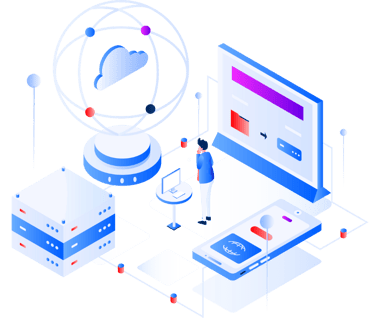iPaas, SaaS, ETL what does it mean?
Sometimes words may need additional explanations. That is why we have created a list of words and concepts that are commonly used in our part of the data world.
Dictionary
-
SSIS
(SQL server integration services)
A platform for data integration and flow applications. Enables data extraction, transformation, and loading (ETL). -
SQL
(Structured query language)
SQL is a standardized programming language for retrieving, modifying, and storing data in relational databases or data streams. -
SaaS
(Software as a service)
SaaS means you do not need to own a specific license but rent the software and all the infrastructure that comes with it. SaaS is the software part of an overall solution, with PaaS and IaaS being the other parts. The user does not need to think about underlying requirements for the function but can use it as any service or software; SaaS is practically always a cloud service available via the internet. -
iPaaS
(Integration Platform as a Service)
Integration platform as a service (iPaaS) is a cloud-based solution that allows businesses to connect different applications and systems to exchange data and automate processes. PaaS provides a range of tools and features, such as data integration, data transformation, and data flow management, which can be accessed through a subscription-based model. iPaaS offers a flexible and scalable way to manage data integration projects. It allows businesses to quickly and easily connect various systems and applications without needing in-house infrastructure or IT resources. -
PaaS
(Platform as a Service)
PaaS refers to offering a platform, such as Microsoft Azure, used to build and develop applications for the business. -
Extract, transform, load
Extract data from source systems, consolidate and convert the data to the desired format in the cloud, and then write the data to a specific storage format. The data can then be analyzed in the database or transferred to BI tools.
-
Data warehouse
A data warehouse is a database where large amounts of data (Big Data) from multiple sources are collected and divided into tables, preferably in SQL. This can then be called from other types of programs, such as BI solutions, to extract information unavailable in the source systems.
-
Data mining
Data mining involves applying algorithms that allow new information to be derived from the analyzed data. It is seen as the fourth step in the KDD (Knowledge Discovery in Databases) process and is the step when the results are obtained.
-
Data lake
A data lake refers to a large amount of data that has not been processed and remains unchanged. Used in Big Data contexts.
-
Data cleansing
Data cleansing refers to improving data quality by finding errors or conflicting/incorrect data and then correcting or updating the data.
-
Cloud computing
Cloud computing refers to IT services available over the internet, such as data storage or analysis tools. They are available through cloud servers such as Microsoft Azure Cloud.
-
RPA
(Robotic Process Automation)
Software that handles activities in a defined process, allowing staff to focus on non-repetitive work. -
Key figures
To provide a simple picture of often advanced and data-heavy reports, key figures describe how a parameter develops over time. These are used to evaluate the performance of a company or unit. Examples include:
- Inventory turnover rate
- Order stock
- Gross margin
- Payment time & Credit time
- Market share
- Revenue growth
-
MDM(Master Data Management)
To create a structured handling of Master Data within the organization, we define common terms.
This is necessary to improve data quality, which is important to create new business opportunities, lower costs and streamline operations.
In working with MDM, we define important rules that must be followed. These rules govern how data is handled and what information is mandatory.
For example:- To have a project number on all transactions for specific projects.
- To have the correct and necessary information in product descriptions.
- To have important information for doing business, follow-up, and aftermarket management in customer orders.
Master data management" also involves designing and maintaining processes that ensure the continued quality of Master data. Processes for this can include data cleansing, monitoring, and synchronization of information from multiple systems, for example: Customer data is often stored in multiple systems: invoicing, CRM, finance, and support systems.
An important part of successfully implementing a "Master data management" project is providing the business with the right tools. BusinessCloud provides the organization with the right conditions, automatic information checks between systems, data cleansing, error reports, warnings, and more. -
Master Data
The standard data for an organization, company, or agency is called master data. This can be, for example, information about customers, employees, suppliers, contracts, product descriptions, article registers, or other types of data used in business processes and IT systems.
-
KPI
(Key Performance Indicator)
KPI stands for Key Performance Indicator and refers to how you can assess a company's performance as a whole or within separate areas/processes using fixed numbers/calculations.Other names may be CPI (Critical Performance Indicator) or GPI (General Performance Indicator).
- Lead time
- NPS (Net Promotor Score)
- Profit margin
- Forecast accuracy
-
Balanced Scorecard
A Balanced Scorecard is used to evaluate a business from multiple perspectives. These can include financial, efficiency, quality, customer, or employee perspectives. Key indicators from each area should ensure that the company is developing in the right direction.
-
BI
(Business Intelligence)
BI stands for Business Intelligence and refers to solutions, knowledge, methods, techniques, applications, processes, analyses, and methods for companies to understand and track their business to make better decisions based on data. -
Budget and forecast
Budget and forecast are used to predict the future financial status of an organization. The budget is the basic outline for the business year, while the forecast is an update of the budget with known parameters that are updated when the budget's assumptions change. It is not only the management of the company that benefits from forecasting; it is also important for everyone in the company to have an insight into the future. This creates an understanding of an organization's decisions and choices during development.
Therefore, it is good to have key performance indicator reports that the entire company can access. It benefits the company when the staff sees the organization's current and future situation. We have built a Budget and Forecast tool that simplifies and enables a quick and easy process tailored to your organization and circumstances.
-
Dashboard
Dashboard refers to the visual representation of a report showing the current status of key metrics through graphs or tables. It is used to disseminate information within an organization.
-
Data quality
Data quality can be described as data that is "fit for purpose" and accurately reflects what is being requested.
Data quality can be measured by data being:- Correct (Accuracy)
- Relevant (Valid)
- Consistent (Consistent)
- Complete (Complete)
- Reliable (Reliable)
- Current (Current)
- Comparable (Comparable)
It needs to be easy to understand and apply to the business to validate the data and make it usable.
Contact us
Business Cloud gives you the tools of the future for integrations today. Contact us and we'll show you how Business Cloud can help you with your data needs today.


